Cambridge
Explore hidden histories, historic photos, and things you never knew about Cambridge from the collections and archives of Historic England.
Discover your local listed buildings and places
Introducing some of Cambridge's most historic sites, included in the National Heritage List for England. Some of these captions have been summarised by AI. Click through for the official List entry. Skip this section and go to place by numbers
King's College
Cambridge
King's College, founded by Henry VI, features notable grounds and iconic architecture like the King's College Chapel and the Gibbs Building, contributing to its historical and cultural...
History Faculty Building
Cambridge
History Faculty Building, built 1964-1968 for the University of Cambridge to the designs of James Stirling, renovated in 1985-1986 by Bickerdike Allen Partners.
Nos. 1-12 Scroope Terrace, the 1959 rear extension to no.…
Cambridge
A C19 terrace extended to the rear in the C19, C20 and C21.
Cambridge University Centre
Cambridge
Cambridge University Centre, designed by Howell, Killick, Partridge and Amis (HKPA) in 1963 and completed in 1967 with structural engineers Samuely and Partners and William Sindall Ltd as...
Botanic Garden, Cambridge
Cambridge
The Cambridge University Botanic Garden was designed by Andrew Murray in 1846, expanded post-1950s, featuring historic and modern plant collections since its initial establishment in 1762.
The Hermitage, Darwin College
Cambridge
Former house, built in 1853, extended around 1870, now part of Darwin College.
Cambridge Judge Business School
Cambridge
The Cambridge Judge Business School, mainly of 1993-1995 by John Outram for the Judge Institute of Management Studies, incorporating the former Addenbrooke's Hospital, built in the mid-C18,...
214 Chesterton Road
Cambridge
Private house designed in 1971 by Marcial Echenique for himself, working with the engineer P. Dann.
Botany Building, University of Cambridge
Cambridge
University department building, built 1901-1904 for the School of Botany, University of Cambridge, to the designs of W C Marshall, extended in 1933-1934 to the designs of T A Lodge.
The Church of Our Lady of the Assumption and the English …
Cambridge
A Roman Catholic parish church constructed between 1887 and 1890 to the designs of Dunn and Hansom of Newcastle.
Dining Hall, Darwin College
Cambridge
College dining hall, designed 1965-1966 and built 1967-1969 to the designs of Bill Howell of Howell Killick Partridge and Amis, with Felix J Samuely and Partners as engineers.
Church of St Andrew
Cambridge
The Church of St Andrew, Chesterton, lies on the north-west side of Church Street, Chesterton.
17, Fitzroy Street
Cambridge
Department Store of 1903, by R. Frank Atkinson, for Laurie and McConnal in an Edwardian 'Wrenaissance' style. Rebuilt at the rear in the late C20 with modern stair tower.
Grove Lodge and outbuilding to south
Cambridge
Villa built in 1798 probably by William Custance, extended in the second half of the C19.
St John's College
Cambridge
St John's College, founded in 1511, features historic courts and gardens from the 17th to 20th centuries, influenced by figures like Christopher Wren and Lancelot Brown.
The David Parr House
Cambridge
Small terraced house, built in the mid-1870s by George Cooper, lived in and painted by the artisan decorator David Parr from 1886 to 1927.
Pembroke College, the Buildings Surrounding Old Court (Ex…
Cambridge
Pembroke College's Old Court features historic architecture from the 14th to 18th centuries, with significant woodwork and panelling. Thomas Gray, the poet, once resided here.
Trinity College
Cambridge
Trinity College, founded in 1546 by Henry VIII, features gardens and architectural designs by Sir Christopher Wren. Its setting includes historic gardens such as The Fellows' Garden.
Gonville and Caius College, the Buildings Surrounding Gon…
Cambridge
Gonville and Caius College features notable historical architecture like the Hall, Chapel, and Gate of Virtue, reflecting styles from the 14th to 19th centuries.
Katharine Stephen Rare Books Library
Cambridge
Library built in 1981-1982 to the designs of Joanna van Heyningen and Birkin Haward.
Church of St Mary the Great
Cambridge
Early C14 chancel. Nave and aisles begun 1478 but not completed until c.1520. W tower begun 1491 but not completed until 1606. Aisle galleries added 1735.
Whewell House, including boundary walls to south and west
Cambridge
Edwardian Baroque house, built 1906 to the designs of Amian Lister Champneys, now in use as student residence of Trinity College.
Emmanuel College
Cambridge
Emmanuel College, founded by Walter Mildmay in 1584, features contributions by Sir Christopher Wren and evolved from a Dominican priory into a site of Puritan scholarship.
Fulbourn War Memorial
Fulbourn
War memorial, unveiled in 1920, carved by T.C. Stanbridge, and dedicated to the fallen of the First and Second World Wars, and the Gulf War.
Mill Road Cemetery
Cambridge
A city cemetery, established by the parochial clergy and opened by the Bishop of Ely in 1848, in response to the creation of a burial ground at Histon Road, Cambridge opened to...
Christ's College
Cambridge
Christ's College was founded in 1437 and refounded in 1505 by Lady Margaret Beaufort. Notable features include historic gardens and buildings dating from the 15th to 20th centuries.
Newnham Grange, Darwin College
Cambridge
Former townhouse, built in 1793 and remodelled in 1885, now a college building.
Queens' College, the Buildings Surrounding Front Court, C…
Cambridge
Queens' College showcases historical architecture with notable elements like the ribbed stone vault in Front Court and Erasmus' South-west corner turret in the South Range.
Upton House, entrance gates and gate piers, garden struct…
Cambridge
Neo-Georgian house built in 1912 to the designs of A. Winter Rose.
Emmanuel College Sports Pavilion, including Groundsman's …
Cambridge
Sports pavilion with attached Groundsman's house and stable, built for Emmanuel College in 1910 to the designs of Reginald Francis Wheatly and Edward Ford Duncanson.
Elterholm, 12 and 12A Madingley Road
Cambridge
Two-storey house with attic storey, built 1888, designed by W C Marshall. Attached fruit store to the north, built 1896, designed by Prince and Sons.
Construction in Aluminium by Kenneth Martin, Department o…
Cambridge
Construction in Aluminium, sculpture, 1967, by Kenneth Martin (1905–1984).
Clare College
Cambridge
Clare College, founded in 1338, features a historic 17th-century layout and iconic bridges designed in Classical style. Notable gardens and pathways enhance its scenic Cambridge location.
Trinity Hall
Cambridge
Trinity Hall was founded in 1350 by Bishop William Bateman and features gardens admired by Henry James in 1878, with architecture spanning from the 14th to the 20th century.
Rayne Building, Darwin College
Cambridge
College gatehouse and accommodation, designed 1965-1966 and built 1967-1969 to the designs of Bill Howell of Howell Killick Partridge and Amis, with Felix J Samuely and Partners as...
All Saints Church
Cambridge
Designed by G F Bodley. Body of church and base of tower 1863-4, spire and tracery in north wall completed 1869-70.
Church of St Paul
Cambridge
The nave and (liturgical) W tower are 1841 by Ambrose Poynter. An aisle chancel and N vestry were added in 1864, possibly to designs by H G Elborne.
Arts School
Cambridge
Arts School, designed as lecture rooms and departmental library by the partnership of George Hubbard and Albert Walter Moore, completed in 1911.
Explore more
Search for more listed placesCambridge through time
This timeline shows the first period of use for buildings and places on the National Heritage List for England, just one of the details recorded for every list entry. Click around to see how Cambridge changes over time. Skip this section and go to aerial photos
Prehistoric Before AD 43
Prehistory covers a million years of human occupation before the Roman invasion, from hunter-gatherers of several human species, including Neanderthals, to more recent herders and farmers. It was a time of developing technologies and belief systems, involving contact with and migration from Europe, all reflected in the variety of artefact and monument types characteristic of particular prehistoric periods.
Early medieval AD 410 to AD 1066
This period, often associated in England with Anglo-Saxons and Vikings, saw a reduction in urban living from the Roman period and increased migration from northern Europe.
Traces of this period can be found in cemeteries, particularly in artefacts and in some of the very early churches, as this period also saw the growth of Christianity in Britain.
Medieval AD 1066 to AD 1540
This period, sometimes known as the Middle Ages, began with the Norman invasion in AD 1066. It saw a significant rise in military and defensive buildings such as castles and earthworks, as well as religious houses dominating a largely agricultural landscape.
The monarchy and Church dominated the period, which also saw the break with the Roman Catholic Church and the English reformation.
Post medieval AD 1540 to AD 1901
The Post-Medieval period brought seismic changes to life in England, with religious reformation leading to the democratization of worship and the destruction of hundreds of religious houses.
In parallel, there was a huge expansion of scientific study and enlightenment that permanently altered the nation's social structure and landscape. Industrialization and mass production lead to wider global trade, emigration, and immigration.
20th century AD 1901 to AD 2000
The 20th century saw an incredible expansion of England's transport networks, with suburban growth shadowing rapid infrastructural expansion. The establishment of state schools, hospitals, and modern technical colleges, with new architectural styles, radically changed the appearance of towns and cities.
Two catastrophic world wars and the 1918 pandemic also brought unprecedented change, altering England's built environment and social structures forever.
Prehistoric Before AD 43
Prehistory covers a million years of human occupation before the Roman invasion, from hunter-gatherers of several human species, including Neanderthals, to more recent herders and farmers. It was a time of developing technologies and belief systems, involving contact with and migration from Europe, all reflected in the variety of artefact and monument types characteristic of particular prehistoric periods.
Early medieval AD 410 to AD 1066
This period, often associated in England with Anglo-Saxons and Vikings, saw a reduction in urban living from the Roman period and increased migration from northern Europe.
Traces of this period can be found in cemeteries, particularly in artefacts and in some of the very early churches, as this period also saw the growth of Christianity in Britain.
Medieval AD 1066 to AD 1540
This period, sometimes known as the Middle Ages, began with the Norman invasion in AD 1066. It saw a significant rise in military and defensive buildings such as castles and earthworks, as well as religious houses dominating a largely agricultural landscape.
The monarchy and Church dominated the period, which also saw the break with the Roman Catholic Church and the English reformation.
Post medieval AD 1540 to AD 1901
The Post-Medieval period brought seismic changes to life in England, with religious reformation leading to the democratization of worship and the destruction of hundreds of religious houses.
In parallel, there was a huge expansion of scientific study and enlightenment that permanently altered the nation's social structure and landscape. Industrialization and mass production lead to wider global trade, emigration, and immigration.
20th century AD 1901 to AD 2000
The 20th century saw an incredible expansion of England's transport networks, with suburban growth shadowing rapid infrastructural expansion. The establishment of state schools, hospitals, and modern technical colleges, with new architectural styles, radically changed the appearance of towns and cities.
Two catastrophic world wars and the 1918 pandemic also brought unprecedented change, altering England's built environment and social structures forever.
Aerial photos of Cambridge
Aerial photography helps reveal secrets of England's changing landscapes that are impossible to see from the ground. Skip this section and go to archive images
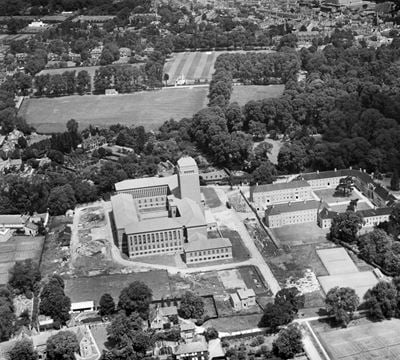
Cambridge
University Library, Memorial Court and St John's College Playing Fields, Cambridge, 1934
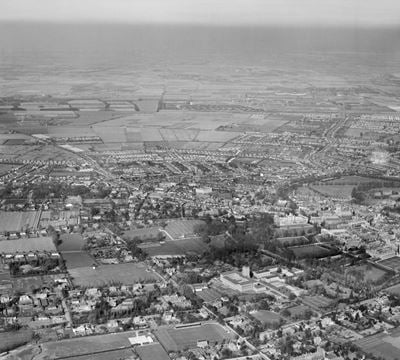
Cambridge
University Library and the city, Cambridge, 1948

Girton
Girton College and the surrounding area, Girton, 1947

Girton
Girton College, Girton, 1947

Cambridge
Jesus College, Cambridge, 1928

Cambridge
Jesus College and environs, Cambridge, 1947
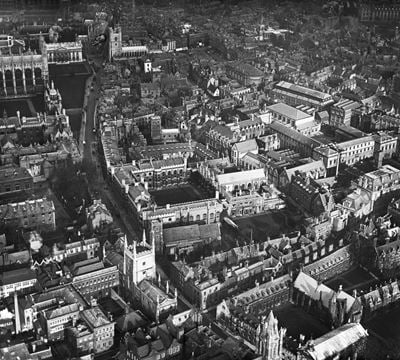
Cambridge
Corpus Christi College and environs, Cambridge, 1920

Cambridge
St John's College, Trinity College, King's College Chapel and environs, Cambridge, 1953
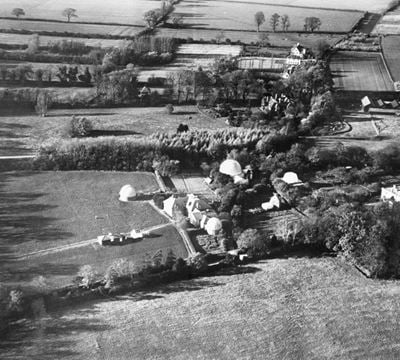
Cambridge
The Solar Physics Observatory alongside Sheepshanks Telescope and Newall Dome, Cambridge, 1928
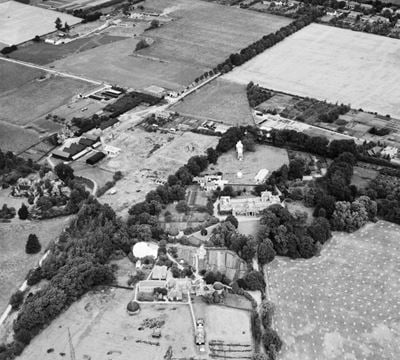
Cambridge
The University Observatory, Cambridge, 1953
Cambridge in the Historic England Archive
The Historic England Archive cares for over 15 million images, dating from the 1850s to the present day. Discover stunning images of Cambridge's past. Skip this section and go to stories about heritage
Charles George Harper Collection
Barnwell Junction, Cambridge, Cambridgeshire
Date created: 1892 - 1933
A view from the south-west of the Chapel of St Mary Magdalene
Eric de Mare
Cambridge, Cambridgeshire
Date created: 1945 - 1980
Detail view of the Hobson's Conduit showing ornamentation around the ogee cupola.
John Gay Collection: London
Cambridge, Cambridgeshire
Date created: 1946 - 1999
Ash twig in leaf, Cambridge Botanic Gardens
John Gay Collection: Modern Architects
Cambridge, Cambridgeshire
Date created: 1978
The interior of Heffers Paperback Shop at 31 St Andrew's Street, showing the entrance lobby with the sign 'heffers: paperbacks' above
John Gay Collection: Counties
Trumpington, Cambridge, Cambridge, Cambridgeshire
Date created: 1946 - 1955
The National Council of Social Service stand at the Royal Agricultural Show at Trumpington near Cambridge
John Laing Collection
Cambridge, Cambridgeshire
Date created: 28 Feb 1986
Interior view of an atrium with mezzanine walkway at Ely School in Cambridge
London, Midland and Scottish Railway Company
Cambridge, Cambridgeshire
Date created: 24 Nov 1927
Interior view of the warehouse of E Purdage and Co in Cambridge
Nigel Temple Collection of Postcards of Parks and Gardens
Cambridge, Cambridgeshire
Date created: 1900 - 1930
INTERIOR VIEW OF THE FERNERY
Walter Scott
Cambridge, Cambridgeshire
Date created: 1935
A punt travelling along the River Cam, with New Court Bridge in the distance
Charles George Harper Collection
Cambridge, Cambridgeshire
Date created: 1892 - 1933
The Chapel of St Mary Magdalene, also known as Stourbridge Chapel, seen from the south-west
John Gay Collection: London
Cambridge, Cambridgeshire
Date created: 1946 - 1999
Ash twig in leaf, Cambridge Botanic Gardens
John Gay Collection: Counties
Trumpington, Cambridge, Cambridge, Cambridgeshire
Date created: 1946 - 1955
Crowds gathered to watch a procession of working horses at the Royal Agricultural Show at Trumpington near Cambridge
Stories about heritage in your local area
Historic England publishes news, blogs, research, videos, and podcasts celebrating England's rich heritage. Discover the stories we have about Cambridge. Skip this section and go to education
Remembering Marietta Pallis, Godmother of the Norfolk Broads
Mentions Newnham College, Kennedy Buildings, Newnham College, House in the College Grounds Circa 100 Yards South of Clough Building
Discover the mysterious life story of ecologist and artist Marietta Pallis, who spent much of her life in the Norfolk Broads.
An Introduction to Artist Henry Moore
Mentions Falling Warrior Sculpture in Clare College Memorial Court
From Yorkshire miner’s son to world-famous artist who revolutionised sculpture in the 20th century.
A Brief Introduction to Christopher Wren
Mentions Emmanuel College, Trinity College
Christopher Wren was a polymath, scientist and world-renowned architect.
The Colourful World of Architect John Outram
Mentions Cambridge Judge Business School
The brilliant colours and exuberant gestures of Outram’s work have captured the popular imagination, yet still retain the ability to shock.
Rock Stars: 8 Women Who Broke New Ground in Geology
Mentions Newnham College, Hall
Women have always had inquiring minds, but have often had to fight harder than their male contemporaries for equal opportunities.
7 Historic Urban Parks and Gardens To Improve Your Wellbeing
Mentions Botanic Garden, Cambridge
Parks and green spaces are vital for our mental and physical health.
6 Places That Tell Stories of the St Ives Art Scene
Mentions Kettles Yard
During the 1950s, many of Britain’s leading artists congregated to St Ives.
How the Cold War Became Heritage
Mentions Regional Seat of Government
9 November 2019 marks the thirtieth anniversary of the fall of the Berlin Wall.
A Brief Introduction to the Post Box
Mentions Letter Box at King's College Gate, King's College, Screens and Entrance Gateway on King's Parade
With over 85,000 post boxes across England, it is likely you pass one every day.
9 Places That Reveal the Hidden History of the Cold War
Mentions Regional Seat of Government
Discover establishments that were once secret to the public.
Fitzwilliam College Cambridge Buildings Listed
Mentions Fitzwilliam College, Central Hall Building, Fitzwilliam College, New Court, Fitzwilliam College, Chapel
The Central Hall Building, New Court and Chapel at Fitzwilliam College, Cambridge, have been listed at Grade II by DCMS on Historic England's advice.
Cambridge University’s Darwin College Protected
Mentions Dining Hall, Darwin College, Rayne Building, Darwin College, Cambridge University Centre
The Dining Hall and the Rayne Building at Darwin College, Cambridge have been listed at Grade II.
Historic England Highlights Fascinating Heritage Sites Listed in 2022
Mentions 1 Silver Street and 71-72 Trumpington Street
As 2022 draws to a close, Historic England highlights gems added to the National Heritage List for England (NHLE) over the last 12 months.
1980s Buildings Officially Become Heritage
Mentions Cambridge Judge Business School, Katharine Stephen Rare Books Library
Historic England announces the listing of 17 Post-Modern buildings
Groundbreaking Women of Science Celebrated
Mentions Newnham College, Hall
Historic England and The Royal Society celebrate International Women’s Day by bringing to light the exceptional achievements of female scientists
Public Asked to Chronicle the Nation’s Missing History
Mentions Cavendish Laboratory of Experimental Physics
The nation's list of historic buildings and places is now open to public contributions for the first time ever.
Cambridge's social history through photos
Over 10,000 images from the Historic England Archive have been specially selected and re-captioned for teachers, students, and anyone who wants to learn more about their local area. Skip this section and go to grant-aided places
Westcott House, Cambridge, Cambridgeshire
Period: Victorian (1837 - 1901)
This building was constructed in 1899-1929. The building appears as an attractive Tudor court.
Westcott House, Cambridge, Cambridgeshire
University Centre, Granta Place, Cambridge, Cambridgeshire
Period: 1960s (1960 - 1969)
A view of the University Centre from the site of the former King's Mill on Laundress Green.
University Centre, Granta Place, Cambridge, Cambridgeshire
Union Society Building, Cambridge, Cambridgeshire
Period: Victorian (1837 - 1901)
The Union Society Building was constructed in 1866 by Alfred Waterhouse. The Cambridge Union Society is a debating society.
Union Society Building, Cambridge, Cambridgeshire
Trinity Hall, Cambridge, Cambridgeshire
Period: Medieval (Middle Ages) (1066 - 1484)
This shows the buildings surrounding Front Court of Trinity College.
Trinity Hall, Cambridge, Cambridgeshire
Tags
The Senate House, Cambridge, Cambridgeshire
Period: Georgian (1714 - 1836)
The Senate House was constructed between 1722 and 1730 by James Gibbs in a neo-classical style.
The Senate House, Cambridge, Cambridgeshire
The Cockerell Building (Squire Law Library), Cambridge, Cambridgeshire
Period: Victorian (1837 - 1901)
This building was constructed by C. R. Cockerell in 1837-40.
The Cockerell Building (Squire Law Library), Cambridge, Cambridgeshire
Tags
St Mary Magdalenes Church, Cambridge, Cambridgeshire
Period: Medieval (Middle Ages) (1066 - 1484)
Formerly the chapel of the Leper Hospital at Stourbridge, the church is one of the most important Norman buildings of the county consisting of a flint...
St Mary Magdalenes Church, Cambridge, Cambridgeshire
Regional Seat of Government 4, Brooklands Avenue, Cambridge, Cambridgeshire
Period: 1950s (1950 - 1959)
A filter bank in the E plant (ground floor) plant room. Nuclear, chemical and biological contamination had to be filtered out.
Regional Seat of Government 4, Brooklands Avenue, Cambridge, Cambridgeshire
Visit grant-aided places near you
These places and buildings have been helped by Historic England's financial grants. Find local heritage in your neighbourhood that you never knew existed! Please note that opening times may vary. Skip this section and go to related locations
Cambridge Museum of Technology, The Old Pumping Station, Cheddars Lane, Cambridge
The Cambridge Museum of Technology, situated in Cambridge, is an industrial heritage museum housed in a scheduled monument.
Discover more
Ready for more local stories? Take a look at these other places nearby

Cambridge
Local Authority District

South Cambridgeshire
Local Authority District

Cambridgeshire
Ceremonial County